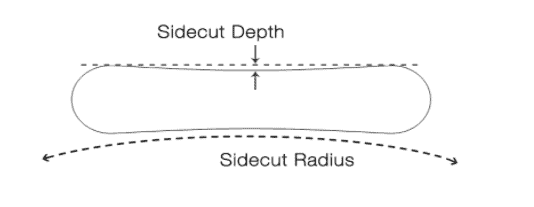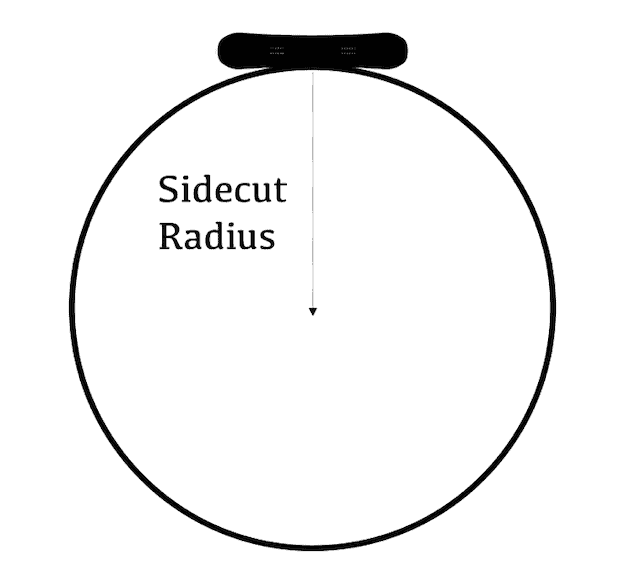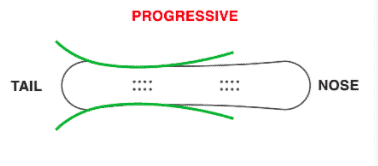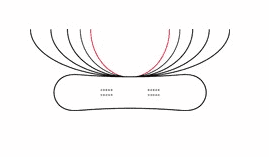The sidecut of a snowboard can be a confusing topic in snowboard technology, especially as a beginner. In this article I want to explain what sidecut on a snowboard means and how sidecut will affect your snowboarding.
What is Snowboard Sidecut?
Snowboard sidecut is the arc that runs along the edge of a snowboard from the nose to the tail. The depth of that curve determines how sharp the snowboard will turn. The term used to measure sidecut is known as sidecut radius and is measured in meters.

The easiest way to think about sidecut is to envisage the arc of your snowboard being part of a larger circle. The radius of a circle is the distance from the outside edge to the centre of the circle.
If the sidecut is deep, then the radius is short and the circle will be small.
If the sidecut is shallow, then the radius is long and the circle will be large.

If you have enough speed, when you make a carve turn you can complete an entire circle. The size of that circle is determined by the depth of your sidecut. So for example, a snowboard with an 8 meter sidecut refers to it’s ability to carve an 8 meter radius turn.
To make the turn any bigger the edge will need to be released creating a slide turn rather than a pure carve turn. However, it is possible to create a smaller radius turn than determined by the sidecut length alone. This is done by using the flex of the board. Through applying force through the board, the board flexes or bends thus deepening the radius of the sidecut.
The turning radius can be shortened but never lengthened.
So for example, a snowboard with a 10 meter sidecut can make a 10 meter turn or through using the boards flex, it can be shortened to 8 meters. However, a snowboard with an 8 meter sidecut can make an 8 meter turn but not a 10 meter turn.
How Does Sidecut Affect Your Snowboarding?
There are benefits to having both long and short radius sidecuts on a snowboard.
Snowboards with larger, more shallow sidecuts will make bigger turns and feel more stable at speed. Transitioning from edge to edge will feel easier when compared to a deeper sidecut. This type of sidecut is typically suited to big mountain free-riders.
Snowboards with shorter, deeper sidecuts will make shorter, more snappy turns. The turns will be easier at slow speeds when compared to a shallow sidecut. This type of sidecut is typically suited to freestyle riders.
Related Reading
- What snowboarding binding angles should I use?
- How to setup your snowboard stance
- A guide to snowboard boot flex
Different Types of Sidecuts
Radial sidecut
Traditionally, all snowboard sidecuts were radial sidecuts which were transferred from sidecuts used in skiing. A radial sidecut is simply a sidecut that has one arc from nose to to tail. (As explained above). Radial sidecuts are commonly found on twin shaped snowboards.
Learn more about snowboard shapes in this guide.
Progressive sidecut
Rather than having the same circular arc throughout it’s entire length, a progressive sidecut will have more of an egg-shaped arc (with the fat end of the egg at the tail!). The nose of the board will have a shallow sidecut for quick turn initiation, whilst the tail of the board will have a deeper sidecut to explode out from the turn.
Progressive sidecuts are commonly found on directional boards.

Combination or multiple sidecuts
Combination sidecut snowboards will have different sidecut radii throughout. For example, it might have a deep sidecut in the centre of the board which gradually gets shallower towards the nose and tail.

You also have boards which have deeper sidecuts at tip and tail and shallow or even flat sidecut at the centre of the board. This is the case with Never Summer’s Vario Power Grip technology and Arbor’s tri-radial GripTech.
Whichever combination is used, these technologies will affect how the snowboard turns and grips. Ultimately manufacturers are aiming to get the best of both worlds – shallow sidecut and deep sidecut.
Wavy edges
When looking at snowboard edges you will also come across edges that appear to be wavy or serrated. This concept was originally created by Mervin (Lib Tech) and was termed Magne Traction.
This technology produces more contact points with the snow which provides more grip in hard pack conditions. This is particularly helpful with rocker boards which tend to have less edge control on hard pack conditions.
The serrated edge could be classed as a type of progressive sidecut, since the serrations themselves create lots of mini sidecuts. However, on Magne traction boards the sidecut radius is measured along the apexes or tops of the bumps and is measured as one radius. To learn more about wavy edges/ Magne traction, take a look at this article.
It’s important to note that the way the snowboard turns is not just a matter of sidecut. It is also affected by the flex (or stiffness) of a board and the camber profile. To learn more about snowboard camber, take a look at this article.
Asymmetrical sidecut
Most snowboards are symmetrical which means that the sidecut is the same on both edges (toe edge and heel edge). However, when we ride a snowboard we stand sideways and lean from our heels to our toes. Moving in this way our bodies aren’t symmetrical – as will know, balancing on your toes feels very different to balancing on your heels.
In order to combat this, some companies have created snowboards where the sidecut on the heel edge is different to the sidecut on the toe edge. Since anatomically the heel edge is a harder turn, the sidecut radius on the heel edge is shorter/deeper. This makes it easier to initiate a turn on the heel edge.
Lifted edges
Finally another design you might come across is a snowboard with lifted edges. Most snowboards are flat from edge to edge (along the base), however on some snowboards the edges can be lifted off the snow. They might be lifted along the entire length of the board or they might just be lifted on the nose and tail.
These lifted edges will provide more of a floaty feel and mean you’re less likely to catch an edge. Since they are lifted, whilst it doesn’t affect the sidecut of the snowboard it will be a contributing factor in how the snowboard turns.
Snowboard Sidecut Summary
The sidecut on a snowboard is the arc that runs along the edge from nose to tail. The depth of a sidecut will affect the length of the snowboard’s turn and the ability to hold that turn at speed. Often a combination of sidecut lengths are used along the same edge in order to maximise the benefits.
Which sidecut radius you prefer will depend on your riding style. However, try not to overthink sidecut radius too much. Typically the sidecut of a snowboard will match the purpose that board was designed for. For example, carving specific boards will typically have a longer sidecut radius whereas freestyle orientated boards will have a short to medium sidecut radius.
So whilst it’s good to have an understanding of sidecut radius, when deciding which board to buy, focus more on what type of riding you want the board to do.
